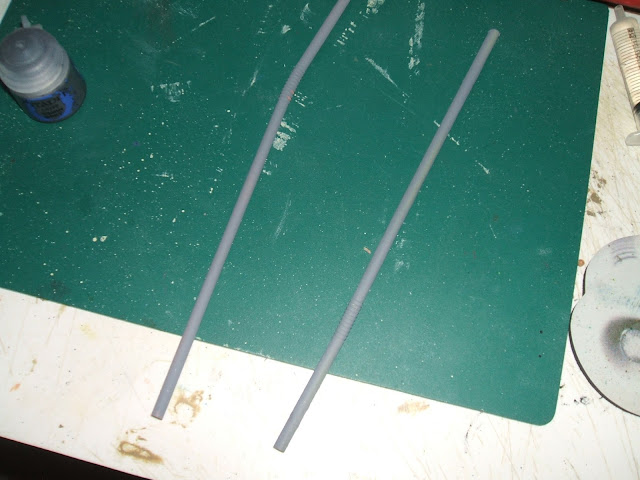Ladies and gentlemen, step right up! Witness the wonder of the modern age! Behold the incredible discoveries wrought in the name of Science!
Apologies to any real scientists reading this. I haven't a large enough sample pool, and my selection criteria are probably way off base. Anyway, I attempted two experiments lately, and wanted to share the results with you. First, I was inspired by Nicholas Lloyd, Lindybeige on Youtube, whose blog mentions coating 1/72 soft plastic figures in undiluted PVA (Elmer's glue a l'américaine) prior to painting, as it doesn't obscure detail too much, and stops the paint flaking off - especially from flimsy bits such as swords and bayonets. I have had some success with that. It's worked very well on British and French models, but less well on some Revell Prussians. I neglected to inspect them closely, so they may just have been less sharply defined in the first place.
Anyway, I wondered if that would work on bendy drinking straws. Years ago I tried to use these in club terrain projects, and the inevitable consequence was that they shed paint like it was going out of fashion. In short, it doesn't work. I took two such straws, covering one with undiluted PVA, and left it to dry. Once dry, I undercoated both with Halford's grey car primer, and then painted them with some GW metallics. Once they were both done I left them for a few days so they had a chance to set. Afterwards, I subjected them to a severe stress test: rolling them harshly in my palms. The glue didn't help at all. As you can see from the photograph, they were both rendered equally bald. A major difference between bendy drinking straws and soft plastic soldiers is that the former are hollow, so I may follow up this experiment. For now it's still a no to bendy drinking straws.
I conducted a second experiment over the past day, again inspired by Lindybeige and another Youtuber (apologies for forgetting who! If I remember or somebody lets me know, I'll edit the name in). I popped into Hobbycraft the other day, and picked up a packet of 80 of those giant lollipop sticks (tongue depressors, are they?) to use as bases for hedges (that was what the nameless Youtuber had done. Lindybeige comes in as one of his recommendations is to apply cheap UHU glue as a base to the top of cardboard to prevent warping.
Since I have eighty of the things, I thought I would actually bother performing a test for once. I took three sticks, coating one with UHU, a second with undiluted PVA, and a third with a diluted PVA mix (something like 50-50 PVA and water). After drying, I compared them with an untreated stick. The untreated stick was flat. The UHU stick was slightly warped, the diluted PVA stick slightly more, and the pure PVA one is noticeably concave (or convex if you flip it). I presume the explanation is that the UHU doesn't really penetrate the wood, while the PVA does. The deeper penetration or the weaker strength of the diluted PVA could both explain its lesser impact on the curve of the wood. Truth be told, while the curvature is noteworthy in person, it doesn't photograph at all well. Successful experiment says: use UHU like Lindybeige already said.
Anyway, have a few photos of my scientific foray.






No comments:
Post a Comment